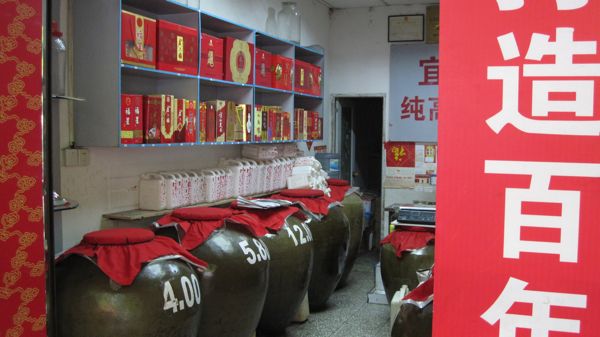Typical rice wine ‘liquor store’ in Chongqing.
Despite 2000 years of struggle to unify the country’s various peoples — from Emperor Qin’s forming of the Dynastic period to Mao’s forcing of the Cultural Revolution — there still is great division on one of the most important topics — wine. Ordering a glass of wine in this country is akin to Russian roulette with a .45 pointed at your taste buds. Depending on what region you are visiting and the ethnicity of the server you are ordering from you might get variations from a clear moonshine-like liquor to a cloyingly sweet grape-based wine beverage.
It took us a while to straighten out exactly what we’d get when ordering. In most tourist-frequented restaurants the menu breaks down the wines into ‘rice’, ‘dry’ and ‘sweet’ and even ‘liquor’. We assumed that dry and sweet were referring to grape-based wines. The Chinese have had a sweet tooth with grape wines — lumping the grape in with other fruit wines and producing them in a similar style. Only in the last two decades have more western-style dry wines entered the market en mass with plantings of cabernet, merlot, and syrah produced with the help of foreign winemakers. Its now poised to be the largest market for ‘wine’ in the world – but that’s another post.
We focused on the rice wines, but still weren’t sure what we were going to get. Sometimes we pointed to the menu and got a quaint little ceramic jar filled with an earthy salty brown liquid – akin to a manzanilla sherry. Other requests summoned a little clear bottle of equally clear liquid that can only be described as drinking shards of red-hot crushed glass — why was THAT under wine on the menu?? At one of our arranged meals we were presented with a little three-legged glass of a warm milky juice and the server said, “It’s wine.” We had to figure this out — how else could we have proper pairings with our Schezuan pork jowls and crispy-fried scorpion? (Only somewhat kidding.)
The most common types of Chinese rice ‘wine’ (Jiu or MiJiu) you’ll encounter are as follows…
BaiJiu
BaiJiu is a distilled alcoholic Chinese beverage normally derived from rice or wheat (in the north and west) and corn (in the south and east) and reaches alcohol by volume levels of 40 to 60 percent. The direct translation of BaiJiu into English is “white wine” — one reason you’ll be surprised if you order a white wine spritzer in Guilin. BaiJiu is more akin to vodka, moonshine, or paint thinner and will burn all the way down, hence the common name, shaojiu (burned liquor). It is considered the national drink of China and will inevitably show up on your dinner table to toast with new friends.
BaiJui distilled brown rice wine ‘liquor’ in a ceramic bottle purchased at a Yichang convenience store for US $2.25.
120 proof BaiJui – great for cleaning open wounds or greasy car parts and not so much for drinking straight.
BaiJui is often used as the base for more adventurous medicinal cocktails, such as this poisonous snake wine for male virility.
HuangJiu
HuangJiu or “Huang (yellow) Jiu (wine)”is a generic term for alcohols made from rice that have been fermented. This is the broadest category of wines that have a vast classification based on levels of sweetness/dryness and production methods imparting a range of fragrances from ‘sauce’ to ‘honey.’ The color of most yellow wines is amber, or dark brown, and get their color during the brewing process as the sugars carmelize. The alcohol content is fairly low at 10-20 percent, making it smoother and easier to drink. Shaoxing wines are known to be the best style and highest quality production and are the ones you will most likely find in the Duty Free shop at the airport displayed in well-appointed ceramic vessels and gift-wrapped in red bows and gold-flaked paper. But just as Champagne has become a catch-all name applied to bubbly sparkling wine, importer Chinese Rice Wine notes the same has happened with the Shaoxing designation:
“Shaoxing Wine or Shaoxing Rice Wine: Shaoxing is an appellation. Shaoxing is an area of China about 100 miles Southwest of Shanghai and is famous for its rice wine production, much like Napa Valley or Bordeaux are known for their grape wine production. The combination of wind, rain, water and location combine to produce a glutinous rice that turns the Shaoxing wine into what is widely recognized as the best rice wine in the world. Unfortunately, not all Shaoxing wines are actually from Shaoxing, as over the years many rice wines have fraudulently put the name Shaoxing on their labels, the majority of them exported from Taiwan.”
HuangJui is a fermented rice wine with lower alcohol and smoother flavors.
ChouJiu
ChouJiu is a version of HuangJiu that is an unfiltered rice wine similar to a Japanese nigori-style wine. It gained popularity in the Tang Dynasty (known to be a time of prosperity with a great emphasis on leisure-time activities, food and wine) with its capitol in today’s Xi’an. Many of the wines, especially ChouJiu, were heated in three-legged wine vessels called Jia and, true to form, it is typically served warm today in the local restaurants. It has an earthy, salty, and slightly sweet taste.
ChouJui is an unfiltered rice wine from Xi’an and its environs normally served warm. Photo Credit: Ulterior Epicure
A couple local stores in NYC Chinatown carry an extensive array of Chinese rice wines:
Marks Wine & Spirits Ltd
53 Mott St @ Bayard St [map]
New York, NY 10013
Elizabeth Street Wine & Liquor
86 Elizabeth Street @ Grand Street [map]
New York, NY 10013


